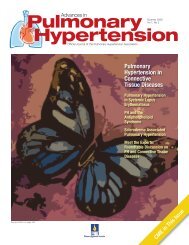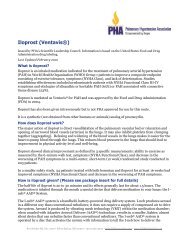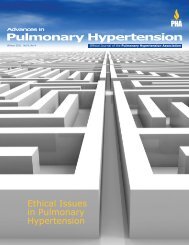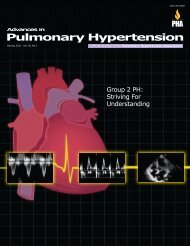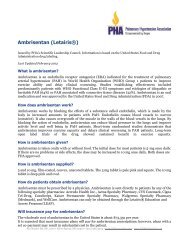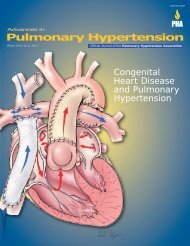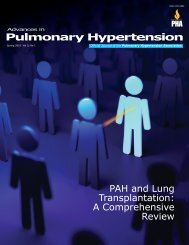Vol 7, No 3 - PHA Online University
Vol 7, No 3 - PHA Online University
Vol 7, No 3 - PHA Online University
Create successful ePaper yourself
Turn your PDF publications into a flip-book with our unique Google optimized e-Paper software.
mal metabolism, some electrons leak from the respiratory chain,<br />
which results in the generation of reactive incompletely reduced<br />
forms of oxygen, such as superoxide and hydroxyl anions. Increased<br />
electron delivery from increased glucose oxidation or increased<br />
fatty acid oxidation have been shown to increase<br />
mitochondrial ROS generation. 68,69<br />
ROS can severely harm the cell through oxidation of proteins,<br />
DNA (including mitochondrial DNA), and nitrosylation of proteins<br />
(through generation of reactive nitrogen species) and lead to improper<br />
protein function (Figure). Oxidative stress is widely accepted<br />
as a key player in the development and progression of<br />
diabetes and its complications, including cardiac pathologies. 70-74<br />
In diabetes, ROS may be predominantly derived from mitochondria<br />
as opposed to cytosolic origins. 68,75,76 Mitochondria are not<br />
only the origin, but also the target of oxidative stress. In addition<br />
to the direct effects on proteins and DNA, ROS can also induce<br />
mitochondrial uncoupling. 49<br />
Most studies that investigate the effect of ROS on mitochondrial<br />
function in diabetic hearts have been performed in type 1 diabetic<br />
models. In these animal models, cardiac mitochondrial<br />
respiratory dysfunction has been demonstrated and, in some studies,<br />
improved antioxidant defense was able to at least partially, if<br />
not completely, restore mitochondrial respiratory function. 77-80 The<br />
possibility that the mechanisms by which ROS causes mitochondrial<br />
damage are similar in type 2 diabetes and is supported by<br />
several similar observations in type 2 diabetic models. 49,78,81-83<br />
A recent study suggests that mitochondrial ROS overproduction<br />
may play a greater role in impairing mitochondrial energetics<br />
in models of insulin resistance and obesity versus models of insulin<br />
deficiency and type 1 diabetes. 84 It appears likely that ROS<br />
plays a central role in impaired mitochondrial energy metabolism<br />
by participating in mitochondrial uncoupling (in type 2 diabetes<br />
and cardiac efficiency) thus directly damaging mitochondrial proteins.<br />
Both mechanisms probably contribute to a deficit in energy<br />
reserve and contribute to the development of contractile dysfunction.<br />
Cardiac performance also depends on the influx of Ca2+. It exposes<br />
active sites on actin, which interact with myosin crossbridges<br />
in an energy-requiring reaction. At the end of the contraction,<br />
Ca2+ is rapidly removed from the cytosol. Ca2+ exchange<br />
between these subcellular compartments is believed to provide a<br />
mechanism for matching energy production to energy demand<br />
under physiological conditions or increased workload and is<br />
termed the “parallel activation model.” 85<br />
Although some Ca2+ is exported via the sarcolemmal membrane,<br />
the bulk of Ca2+ is resequestered in the sarcoplasmic reticulum<br />
by the activity of sarcoplasmic/endoplasmic reticulum<br />
Ca2+-ATPase 2a (SERCA2a). 86-88 Contractile dysfunction in the<br />
diabetic heart has been proposed to be the consequence of abnormalities<br />
in sarcoplasmic reticulum Ca2+ handling and has<br />
been specifically attributed to the decreased expression of<br />
SERCA2a. 89-93<br />
It has recently been demonstrated that mitochondrial biogenesis<br />
occurs in hearts of obese and insulin resistant animals. 44,45<br />
However, this was not associated with increased mitochondrial<br />
respiration or ATP generation. We have also observed increased<br />
mitochondrial density and DNA content in ob/ob and db/db mice<br />
despite impaired ADP stimulated respiration and ATP synthesis.<br />
43,44,49 These observations raise the question whether mitochondrial<br />
biogenesis is adaptive or maladaptive in the metabolic<br />
syndrome.<br />
Given that animal models of the metabolic syndrome exhibit<br />
insulin resistance the question arises whether cardiac insulin<br />
resistance may contribute to the development of contractile<br />
dysfunction. Since the animal models are characterized by systemic<br />
metabolic alterations, evaluation of the contribution of insulin<br />
resistance to cardiomyocyte contractile dysfunction is<br />
challenging. To approach this problem, we generated mice with a<br />
deletion of the insulin receptor (CIRKO mice) restricted to the<br />
cardiomyocyte. 94<br />
CIRKO mice have reduced insulin-stimulated glucose uptake<br />
and also have a modest decrease in contractile function, thereby<br />
insulin resistance may be a contributing factor in contractile dysfunction<br />
in the metabolic syndrome. This may be caused by decreased<br />
mitochondrial gene expression, which limits oxidative<br />
capacity and impairs mitochondrial energetics and contractile<br />
function in CIRKO mice. If this is correct, then CIRKO hearts may<br />
be more susceptible to injury when subjected to increased energy<br />
demands<br />
CIRKO mice subjected to pressure overload through transverse<br />
aortic banding or following chronic β-adrenergic stimulation<br />
resulted in worse left ventricular dysfunction, left ventricular<br />
dilation, and interstitial fibrosis compared to controls. 95,96 These<br />
findings support the notion that insulin resistance may play a<br />
role in the development of contractile dysfunction in the metabolic<br />
syndrome, and impaired myocardial mitochondrial oxidative<br />
capacity due to reduced insulin action could be an underlying<br />
mechanism.<br />
Conclusion<br />
It is probable that no one single mechanism, but rather the combination<br />
of several mechanisms, leads to cardiac dysfunction in<br />
the metabolic syndrome. We propose that mitochondrial dysfunction<br />
compromises cardiac ATP generation and leads to contractile<br />
dysfunction. <strong>No</strong>vel treatments that target these abnormalities<br />
might lead to new therapeutic avenues for the prevention<br />
of cardiac dysfunction. What is not known is if the mechanisms<br />
of cardiac dysfunction outlined above can be extrapolated<br />
to the right ventricle.<br />
References<br />
1. Zimmet P, Alberti K G, Shaw J. Global and societal implications of the diabetes<br />
epidemic. Nature. 2001;414:782-787.<br />
2. DECODE. Glucose tolerance and cardiovascular mortality: comparison of<br />
fasting and 2-hour diagnostic criteria. Arch Intern Med. 2001;161:397-405.<br />
3. Kenchaiah S, Evans JC, Levy D, et al. Obesity and the risk of heart failure.<br />
N Engl J Med. 2002;347:305-313.<br />
4. Stamler., Vaccaro O, Neaton JD, Wentworth D. Diabetes, other risk factors,<br />
and 12-yr cardiovascular mortality for men screened in the Multiple Risk Factor<br />
Intervention Trial. Diabetes Care. 1993;16:434-444.<br />
5. Ho KK, Pinsky JL, Kannel WB, Levy D. The epidemiology of heart failure:<br />
the Framingham Study. J Am Coll Cardiol. 1993;22:6A-13A.<br />
6. Kannel WB, McGee DL. Diabetes and cardiovascular disease: the Framingham<br />
study. J Am Med Assoc. 1979;41:2035-2038.<br />
7. Regan TJ, Lyons MM, Ahmed SS, et al. Evidence for cardiomyopathy in familial<br />
diabetes mellitus. J Clin Invest. 1977;60:884-899.<br />
8. Bell DS. Diabetic cardiomyopathy. Diabetes Care. 2003;26:2949-2951.<br />
9. Fein FS. Diabetic cardiomyopathy. Diabetes Care. 1990;13:1169-1179.<br />
10. Szczepaniak LS, Dobbins RL, Metzger GJ, et al. Myocardial triglycerides<br />
and systolic function in humans: in vivo evaluation by localized proton spectroscopy<br />
and cardiac imaging. Magn Reson Med. 2003;49:417-423.<br />
11. Sharma S, Adrogue JV, Golfman L, et al. Intramyocardial lipid accumulation<br />
in the failing human heart resembles the lipotoxic rat heart. FASEB J.<br />
2004;18:1692-1700.<br />
12. Carley AN, Severson DL. Fatty acid metabolism is enhanced in type 2 diabetic<br />
hearts. Biochim Biophys Acta. 2005;1734:112-126.<br />
334 Advances in Pulmonary Hypertension



